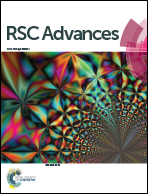Mono- and multifold C–C coupling reactions catalyzed by a palladium complex encapsulated in MIL-Cr as a three dimensional nano reactor†
Abstract
The organic palladium complex (trans-dichlorobis(4-iodoaniline-κN)palladium(II)) was encapsulated into a porous metal–organic framework MIL-Cr (Pd complex@MIL-Cr) using ship-in-a-bottle strategy. The novel catalyst as a three dimensional nanoreactor was fully characterized using different techniques such as XRD, BET, XPS, SEM, EDX, TEM and ICP. The Pd complex@MIL-Cr is isostructural to the parent MIL-Cr framework, with a high surface area and pore volume of ca. 1418 m2 g−1 and 0.87 cm3 g−1, respectively. The nanoreactor was highly efficient in the catalytic conversion of aryl halides, showing extraordinarily higher activity than the homogeneous Pd counterparts. Surprisingly, high yields were achieved in Suzuki–Miyaura and Heck coupling reactions of chloroarenes bearing a wide range of substituents. Besides, this protocol could be extended to the cross-couplings of 2-bromo and 2,6-dibromopyridine with arylboronic acids in excellent yields at room temperature. The Pd complex@MIL-Cr was also used as an efficient and convenient catalyst for the preparation of a series of C3-symmetric molecules with benzene, pyridine or pyrimidine units as the central core. Moreover, the catalyst could be recovered easily and reused several times without any considerable loss of its catalytic activity. Investigation of the nature of the recovered catalyst showed that the catalyst is converted to Pd nanoparticles.



 Please wait while we load your content...
Please wait while we load your content...